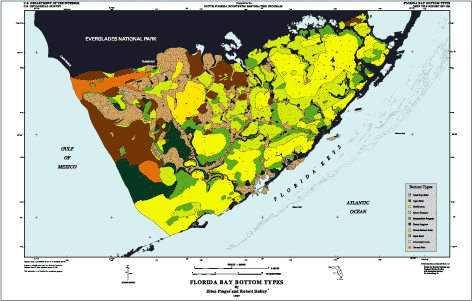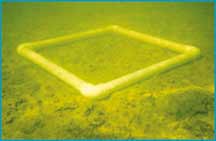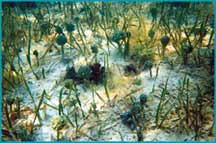Florida Bay Bottom Types
 |
This map is available for download in a variety of formats:
|
Methods
An extensive survey of bottom type in Florida Bay was conducted during the summer of 1996 and completed in January of 1997. A small, flat-bottomed boat, high resolution GPS, and snorkeling gear were used to locate and examine over 650 sites within the Bay. In areas where depth and water clarity permitted, observations from the boat along transects between survey sites were used to identify the extent of bottom types. Over 100 sediment samples were collected and analyzed for grain size, mud, water, carbonate, and organic content (Figure 1 A and B). The enclosed map represents the results of site surveys, boat transects and comparison with aerial photographs (Dec. 1994 - Jan. 1995) and SPOT satellite imagery (1987). Subregions for the Bay used here follow the recommendations of the Florida Bay Program Management Committee (1997).
Bottom Type Descriptions
The purpose of this map is to describe the bottom types found within Florida Bay for use in 1) assessing bottom friction associated with sediment and benthic communities and 2) providing a very general description for other research needs. For these purposes, two descriptors were considered particularly important, density of seagrass cover and sediment texture. Seagrass estimates are visual estimates of the amount of seagrass cover including both number of plants and leaf length. Therefore, seagrass cover may be greater in areas with long leaves than in areas with short blades, even though the number of shoots may be the same. Seagrass cover is a different measure than density (Zieman et al., 1989 or Durako et al., 1996). It is used here to more accurately reflect hydrodynamic influence than the standing crop of seagrass. Our use and definitions of dense, intermediate and sparse seagrass cover are described in the accompanying text and are similar to those used by Scoffin 1970). This map and associated descriptions are not meant to assess ecologic communities or detail sedimentological facies. The resolution of the map has been selected in an effort to define broad regions for use in modeling efforts. For these purposes, small-scale changes in bottom type (e.g. small seagrass patches) are not delineated.
Bank Top Suite
Bank top suite is used to describe bottom types within the Bay commonly called mud banks and occur in depths typically less than 0.6m (following the convention of Scholl and others, 1964). These areas are spatially complex environments that are dominated by carbonate mud, sand or in the western portion of the Bay, gravel. Boscence (1989) has described the mud bank surface as consisting of a series of linear sedimentary facies. The compliment of these facies which include a variety of seagrass densities and open muddy or shellt areas is considered a bank top suite. Due to periodic exposure, seagrass shoot length typically decreases on the top of mud banks. Banks are commonly flanked by zones of intermediate to dense seagrass growth. In addition, north and east facing margins may be topped with a distinctly shelly sand layer or an emergent shell ridge. In the southwestern Bay and the Gulf transition zone, bank tops are often characterized by sand and gravel, along with live coral and Halimeda growth.

[larger image]
Open Mud
Open mud is used to describe areas where no significant seagrass cover occurs and other benthic fauna, with the exception of algal mats, are not apparent. Sediments within these areas are predominantly carbonate mud with a relatively high organic (up to 15%) and water (up to 83%) content. Some of the open mud areas contain a relatively high shell content (17 - 35%) and rarely, exposed seagrass rhizomes at the sediment surface. It is suggested that open mud areas having a high shell content are sites of seagrass mortality which previously supported a live mollusc community. As a bottom type, open mud areas are not distinguished from seagrass die-off areas. Areas of recent seagrass mortality are recognized by extensive exposure of rhizomes or the dead stubble of shoots protruding from the sediment.

[larger image]
Hardbottom
Hardbottom refers to areas having little to no seagrass cover and only up to 5 cm of sediment overlying the Pleistocene limestone bedrock. Fauna indicative of this bottom type are gorgonians, loggerhead or vase sponges. Other benthos which occur, but are not considered indicative, include other sponges, the algal genera Batophora and Penicillus, and various coral species including the genera Siderastrea and Solenastrea. Hardbottom sediments tend to be either slightly muddy carbonate sand or sand, contain relatively little organic matter, and have a low water content. Sparse, intermediate and dense grass patches occur in sediment-filled karst solution depressions in the bedrock. These depressions can be as much as 2 meters deep and up to a few hundred square meters in area. A slightly higher mud content, up to 15 cm of sediment, and Calinassia burrows can also occur on a limited extent.

[larger image]
Sparse Seagrass Cover
Sparse seagrass cover describes areas in which greater than 50% of the bottom is exposed. Penicillus, Batophora and scattered sponges often occur in this bottom type. Sediments are predominantly slightly muddy carbonate sand, sandy mud, or sand and vary from approximately 3 cm to over 2 m in thickness. The organic and water content in these sediments ranges from 0.5 - 13% and from 36 - 77%, respectively. Although sparse seagrass areas are generally muddy, in some areas the coarse fraction may be as much as 20%.

[larger image]
Intermediate Seagrass Cover
Intermediate seagrass describes a bottom type that hasgreater than 50% seagrass cover with open areas of exposed sediment on the bottom (less than 50%). In areas near the Gulf and Atlantic, Calinassia burrows are common. Sponge and Penicillus are also frequently found in this bottom type. Sediments are dominated by sandy and shelly (gravely) carbonate mud. Sediment thickness tends to be greater than 0.33 m and may reach up to over 2 m. Organic and water content vary from 1 - 11% and 41 - 76%, respectively.

[larger image]
Dense Seagrass Cover
Seagrass cover is considered dense where the bottom is completely obscured from view by grass growth. Sponges and blooms of the pearl oyster are common. Carbonate sediments, generally thicker than 0.33 m, are deposited amidst a tangle of seagrass rhizomes just below the surface. These sediments are muddy sand, with a relatively high organic (6 - 8%) and/or shell (10 - 53%) content.

[larger image]
Mixed Bottom Suite
In the west-central region of the Bay is an area exhibiting a highly variable bottom type. Within several meters, variations in seagrass density are extreme and open mud areas occur on what seems to be an irregular basis. Consequently, this region has been termed a mixed bottom suite. During January of 1997, large (m ) patches of seagrass, with rhizomes attached, were observed floating in the area. The patches appeared to be eroded at their edges, and portions of the seagrass mat were peeling off the sediment surface.
Open Sandy Areas
Areas of open sandy bottom occur in the Gulf transition zone of the Bay. These areas are distinct from hardbottoms in that no significant benthic life is present and the sediments are coarse shelly carbonate sands. One large area of east-west running open sand occurs just south of Cape Sable, it is most likely an erosional product of strong tidal flow within the area.
Figures 1 A and 1B


Figure 1A: Surface Sediment Composition (120 Samples) [larger image]
Figure 1B: Grain Size Distribution, Surface Sediments (120 Samples) [larger image]
References
Bosence, D. 1989. Surface Sublittoral sediments of Florida Bay, Bull. Mar. Sci. 44(1):434-453.
Durako, M. J., Hall, M, and Hall, J. 1996. The status and trends of seagrass communities in Florida Bay, In: Programs and Abstracts, 1996 Florida Bay Science Conference, Key Largo, FL: 34-36.
Florida Bay Program Management Committee. 1997. Strategic plan for the interagencey Florida Bay science program, available from Everglades National Park.
Ginsburg, R. N. 1956. Environmental relationships of grain size and constituent particles in some south Florida carbonate sediments. Bull. Am. Assoc. Petrol. Geol. 40(10): 2384-2427.
Scholl, D. W. 1996. Florida Bay: A modern site of limestone formation, in Fairbridge, R. W., ed., Encyclopedia of the Earth Sciences, New York, McGraw Hill Book Co.: 282-288.
Zieman, J. C., Fourqurean, J. W., and Iverson, R.L. 1989. Distribution, abundance and productivity of seagrass and macroalgae in the Florida Keys. Bull. Mar. Sci. 44(1): 292-311.
Acknoledgements
The authors wish to thank NOAA's National Undersea Research Center in Key Largo, the Florida Keys Marine Laboratory on Long Key, and the National Park Service for facilities support. The National Park Service also provided access to SPOT imagery. Our thanks also to Mike Durako, Hal Wanless, Dave Rudnick, Paul Carlson, Bill Lyons and Jim Fourqurean for their review and helpful comments. Additional gratitude is extended to Mark Hansen, Rita Byrd, and Cherie Hulsman-Reid for their mapping skills and perseverance.
Disclaimer
This map is preliminary and has not been reviewed for conformity with the USGS editorial standards (and stratigraphic nomenclature). Any use of trade names is for descriptive purposes only and does not imply endorsement by the USGS.
![]() Click here for a printer-friendly version of this publication (note: document will open in a new browser window)
Click here for a printer-friendly version of this publication (note: document will open in a new browser window)
For more information contact:
Bob Halley
U.S. Geological Survey, Marine and Coastal Program
600 4th St. S.
St. Petersburg, FL 33701
(727) 803-8747
Related information:
SOFIA Project: Sedimentation, Sea-Level Rise and Circulation in Florida Bay
U.S. Department of the Interior, U.S. Geological Survey, Center for Coastal Geology
This page is: http://sofia.usgs.gov
/publications/ofr/97-526/index.html
Comments and suggestions? Contact: Heather Henkel - Webmaster
Last updated:
05 February, 2004 @ 12:13 PM
(HSH)
